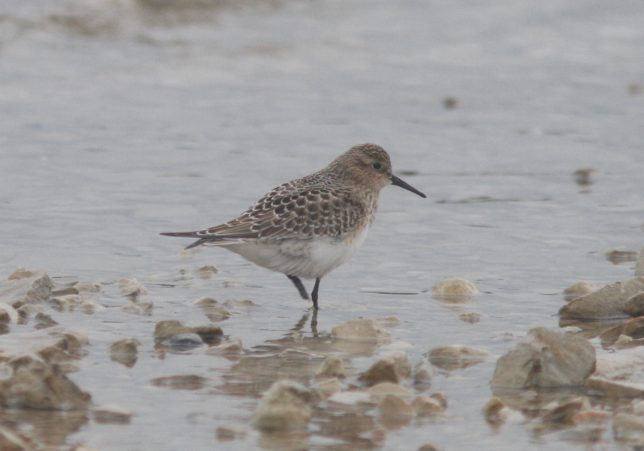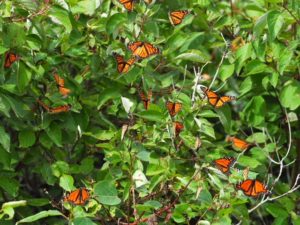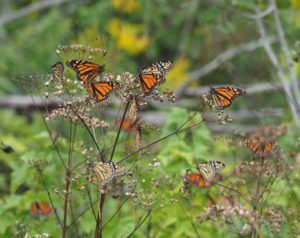Once again rain started off the day and much longer than the forecast called for. In fact, much of the forecasts for today were mostly wrong. The rain showers lasted until 11:00, the winds were light, mostly with a westerly component to them, and there was a fog in the morning. Despite the differences in what the weather actually was, it was way better than I anticipated in every category except warbler numbers.
Raptors: Raptors were strong right out of the gate after the rain/drizzle stopped and remained strong until around 2:30. Diversity was also the best of the season with 12 species recorded, 10 of which were migrants. Broad-winged Hawks were the biggest surprise of the day, with 65 recorded. Most of these gained altitude and flew south over the straits. Sharp-shinned Hawks and Northern Harriers were also well-represented with 17 and 10 birds respectively. Three Cooper’s Hawks were nice, as was an immature Red-shouldered Hawk. Once again the falcon sweep was completed, but only was represented by a lone female American Kestrel. Most birds were rather high today or quickly gained height before crossing.
Non-raptors: Rainy days are quite often good shorebird days and this was the case today. In fact, 2 species of shorebirds actually landed today-Baird’s Sandpiper and Least Sandpiper. A lone Solitary Sandpiper and 5 Pectoral Sandpipers completed the shorebirds for the day. 5 Common Loons and 3 Gadwall were other highlights in the waterbird department and the first Sandhill Cranes (2) of the season were recorded. Northern Flickers had their first push, with 12 birds. Twenty-one Ravens, most of which crossed the straits, were nice, as were both species of Kinglets. 14 warbler species were recorded today, the bulk of which were Common Yellowthroat, American Redstart, and Yellow-rumped. Ovenbird, Bay-breasted, and Yellow Warblers were nice additions as well. Six of the 14 warbler species only involved one individual. Eleven Bobolinks and 12 Pine Siskins round out the non-raptor highlights.
73 species of birds were recorded today.

Monarchs: Incredible, simply incredible all day long!!! During the rainy morning, only a dozen or so were flying around, but once that stopped around 11, they were flying around everywhere for the next 6 hours. More minutes than not you could scan with your binoculars at any one time and see over 50 at one time. They were high in the sky to the west, east and north, they were low throughout the scattered wildflowers in the fields, they were circling over your head half a dozen at a time, and they were between the telephone wires with every scan for raptors. It was an amazing, mesmerizing experience that was like an unending, enjoyable movie. Except, this wasn’t just a movie. No, this movie had a sequel. And the sequel was equally good, if not better. Back to the original though, the Monarchs mostly streamed south for the first several hours and then ESE for the next few hours until around 4:30. Around this time many were starting to fly from east to west and by the time it was 5:00 most were heading west, and the numbers were dwindling significantly. When the show was finally over, a total of 1,674 Monarchs had flown by!!! This was by far the most Monarchs I’d ever seen in a day. Hourly totals are broken down below.
11-12: 188 Monarchs
12-1: 319 Monarchs
1-2: 278 Monarchs
2-3: 264 Monarchs
3-4: 448 Monarchs
4-5: 148 Monarchs
5-6: 29 Monarchs
Monarchs were roosting together starting in the late afternoon with groups of 20 regular near by. Seeing that many Monarchs were flying west between 5 and 6, I headed that way shortly after 6 to see how many hundreds were roosting for the night. Steve Baker had found several groups throughout the area, but the better groups were at the west side of the point. I picked up my mom from Mackinaw to see the show and we were back in the area around 6:30. We quickly came across the first large group of Monarchs and then the next. In one small area there were over 1,000 Monarchs roosting!!! Close by were three more clusters of Monarchs and then even larger clusters next to those!!! I started off counting by 2s, but 8:00 came quick, which necessitated counting by 10s instead so as to attempt to count as many as possible with the remaining daylight. After 8:30 came upon us it was rather hard to see much anymore and we seemed to be cover most areas pretty well, given the short amount of time we had. When all was said and done a roosting total of 3,810 Monarchs was tallied!!! Only 14 of these were east of the hawk watch site, or conceivably double-counted, but surely more than 14 were undetected migrating. Which means the day’s Monarch total ended with 5,484 Monarchs!!! An unforgettable day and evening, although it may just become a blur with the future. That is there may be another movie or several in this series as this seems to be weeks earlier than when Monarchs peak at several other locations in Michigan. Is 10,000 Monarchs a conceivable number in a day if that is the case!?!? It’ll be very exciting to find out, to say the least.


Best of the next 5 days: Tomorrow (Thursday) is the best of the next 5 days and then Friday is. Tomorrow could be another amazing day and the radar right now (11:30 PM) looks incredible for bird migration not only for Michigan, but most of the eastern U.S.

